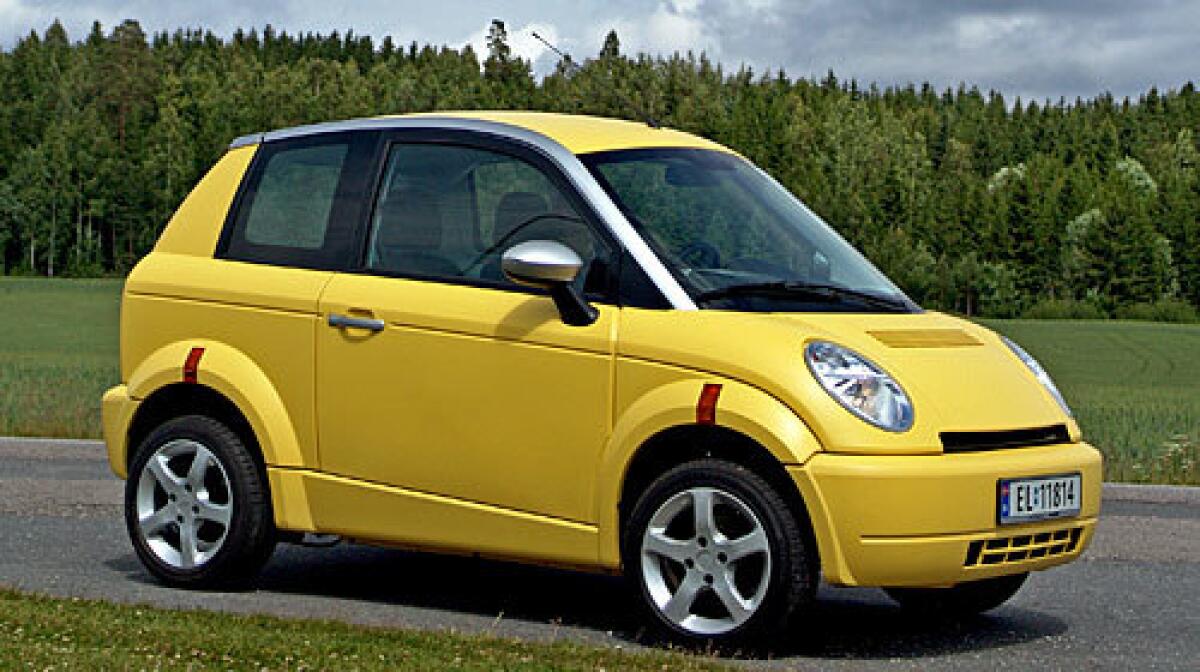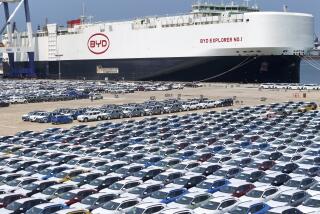The Think City: In Norway, they’re building your first electric car

OSLO, NORWAY — Ingvil Ladehaug is battery challenged.
Her laptop is running out of juice. Her cellphone is down to its last electrons. But the director of communications for Norway’s Think -- beginning production in September of perhaps the best electric car in the world -- feels good about our chances of getting home.
“We’re going to make it!” she squeals as we cross back into Oslo proper. “Fantastic.”
It’s been a long day for our adorable yellow test car. This morning we headed for Think’s factory in Aurskog, some 40 miles into the bluegrass Scandinavian countryside, with about an 85% charge in the car’s advanced sodium-cell battery. But Ladehaug -- who is directionally challenged too -- got us turned around. Now, after several course corrections that added perhaps 20 miles to the trip, we’re both eyeing the battery gauge, while warning lights flash ominously. Still the Think City -- a 2,449-pound runabout with plastic body panels and an official range of 112 miles on full charge -- hums along.
About the size of a Mercedes-built Smart car, the two-seat Think (backseat optional) scoots away from stop lights, thanks to its torque-rich electric motor, and doesn’t feel at all strained at highway speeds of 100 kilometers per hour (62 mph). First impressions: dead solid, quiet, comfortable, fully realized. A real car. It’s got a great look, with big moony eyes as headlamps that make you want to take it home. The brakes are kind of touchy, the pedals are kind of small, the steering a bit leaden. But for the most part, it feels like any other sub-compact economy car, except there’s not an exhaust note. Nor exhaust pipe. When we have to make a quick change in direction -- “Here, this turn!” Ladehaug shouts -- the little car darts in the direction it’s pointed.
Think’s journey to the world market has been similarly full of detours. The company (previously called Pivco) began in 1991 and by 1998 had built more than 1,000 small and charismatic electric runabouts, sold mostly in Norway (where you still see a few on the road). Then, in 1999, the company was bought by the Yankee giant Ford Motor Co., which was scrambling at the time to comply with California’s Zero Emission Vehicle mandate, essentially requiring automakers to build fleets of electric vehicles. Ford renamed the company Think Nordic and began a complete redesign of the car. When, in 2003, the American automakers succeeded in modifying California’s mandate, Detroit’s flirtation with electronic vehicles ended. General Motors Corp. famously killed the EV1 program, and Ford sold Think to a Swiss electronics firm.
“The lawyers stopped us,” says Ole Fretheim, the factory’s manager. Think went bankrupt in 2006.
The irony is that Ford had already poured $150 million into the Think City project, engineering among other things the car’s rigid steel space frame, the crash structure. If and when it comes to the U.S. market -- the company opened an office in Menlo Park, Calif., earlier this year with plans to sell cars stateside in 2009 -- the Think City will be a rarity: A full-speed electric car meeting U.S. and European crash standards.
“The car was 95% complete when Ford stopped development in 2002,” says Fretheim. In the long run, he says, the down time might have been a good thing. “When we started work again we had better options for batteries.”
In 2006, a group of investors led by Jan-Olaf Willums, a Norwegian venture capitalist specializing in energy technology, purchased Think for $15 million. Now Think’s chief executive, Willums has spent much of the last two years raising more money -- about $93 million, much of it from Silicon Valley -- to help get Think off the ground.
“These guys are Vikings. They’re fearless,” says Wilber James, a general partner of RockPort Capital Partners, which invested in Think North America along with Ray Lane of Kleiner Perkins Caufield & Byers. “And they’re absolute leaders in clean technology.”
At the factory, we’re met by the plant director, Arne Degermosse, a 41-year car-building veteran from Saab, brought in to ramp up production. Also this year, Porsche Consulting came in to advise on plant efficiency. With just under 18,000 square feet under the roof, space is at a premium; with two shifts, says Degermosse, the facility can produce just 44 cars a day, or about 10,000 cars a year. Not a number that will have GM shaking in its boots.
And yet, because of the unique modular assembly process -- the car is put together from a mere 580 parts -- it would be possible to set up other assembly plants closer to the markets it serves, namely Southern California. “It’s called distributed manufacture,” says James. “If we were going to build them anywhere in the U.S., Southern California would have priority because that’s where we’d sell them. It’s a precursor of what the OEMs [the big automakers] should be doing.”
In any electric car program, the crucial component is the battery. Think has settled on three suppliers: MES-DEA, which produces a molten sodium battery, and A123Systems and EnerDel, which produce varieties of lithium-ion batteries. The MES-DEA battery yields 28 kilowatt-hours, while the EnerDel and the A123Systems batteries produce 26 and 19 kWh, respectively. Any of the three are expensive. At current market prices, Think’s City could cost up to $35,000, more than half of that tied up in the battery.
For that reason, Willums proposes to sell the cars for $20,000-$25,000 and lease the batteries to owners, for a $150 to $200 monthly “mobility fee.” All battery maintenance and replacement costs would be covered, and there could be ways to compensate owners for the costs of the electricity to charge the cars.
“The real interesting part is what is going to happen next,” says James. “The market has evolved faster than we ever thought.”
Think currently doesn’t know how it will sell the car: Will there be online showrooms or real showrooms? Or will customers go to their local Think assembly plants and watch as their cars are built? What tax breaks will be available, and from whom? Will consumers balk at a rental fee on top of a purchase price?
All these questions remain unanswered. But as for the question so often asked: Is a safe, practical electric car possible? The answer seems to be yes.
2008 Think City Type:Two- or four-seat, three-door electric vehiclePrice: $20,000-$25,000 (est), with monthly battery lease of $150-$200Horsepower: 40Acceleration: 0-50 in 16 secondsTop speed: 62 mphRange: 112 milesWeight: 2,449 poundsBattery: Hot-cell sodium battery (28 kilowatt-hours, 380 volts) or lithium-ion battery (26 kilowatt-hours, 380 volts)Standard equipment: Front airbags, anti-lock brakes, regenerative braking, power steering, power windows and door locksFinal thoughts: The next big Think
More to Read
Sign up for Essential California
The most important California stories and recommendations in your inbox every morning.
You may occasionally receive promotional content from the Los Angeles Times.










